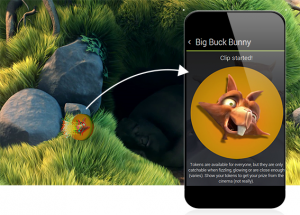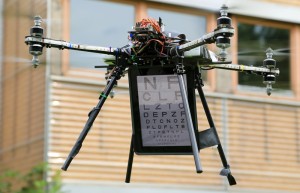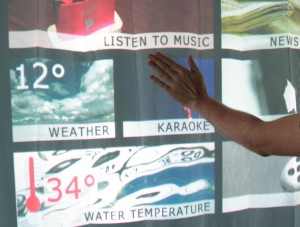After years in the lab, interactive public displays are finding their way into public spaces, shop windows, cinemas, and user`s home. They are equipped with a multitude of sensors as well as (multi-) touch surfaces allowing not only the audience to be sensed, but also their effectiveness to be measured. The lack of generally accepted de- sign guidelines for public displays and the fact that there are many different objectives (e.g., increasing attention, optimizing interac- tion times, finding the best interaction technique) make it a chal- lenging task to pick the most suitable evaluation method. Based on a literature survey and our own experiences, this paper provides an overview of study types, paradigms, and methods for evaluation both in the lab and in the real world. Following a discussion of de- sign challenges, we provide a set of guidelines for researchers and practitioners alike to be applied when evaluating public displays.
Let me catch this! Experiencing Interactive 3D Cinema through Collecting Content with a Mobile Phone
 The entertainment industry is going through a transforma- tion, and technology development is affecting howwe can en- joy and interact with the entertainment media content in new ways. In our work, we explore how to enable interaction with content in the context of 3D cinemas by means of a mobile phone. Hence, viewers can use their personal devices to re- trieve, for example, information on the artist of the soundtrack currently playing or a discount coupon on the watch the main actor is wearing. We are particularly interested in the user ex- perience of the interactive 3D cinema concept, and how dif- ferent interactive elements and interaction techniques are per- ceived. We report on the development of a prototype applica- tion utilizing smart phones and on an evaluation in a cinema context with 20 participants. Results emphasize that design- ing for interactive cinema experiences should drive for holis- tic and positive user experiences. Interactive content should be tied together with the actual video content, but integrated into contexts where it does not conflict with the immersive experience with the movie.
The entertainment industry is going through a transforma- tion, and technology development is affecting howwe can en- joy and interact with the entertainment media content in new ways. In our work, we explore how to enable interaction with content in the context of 3D cinemas by means of a mobile phone. Hence, viewers can use their personal devices to re- trieve, for example, information on the artist of the soundtrack currently playing or a discount coupon on the watch the main actor is wearing. We are particularly interested in the user ex- perience of the interactive 3D cinema concept, and how dif- ferent interactive elements and interaction techniques are per- ceived. We report on the development of a prototype applica- tion utilizing smart phones and on an evaluation in a cinema context with 20 participants. Results emphasize that design- ing for interactive cinema experiences should drive for holis- tic and positive user experiences. Interactive content should be tied together with the actual video content, but integrated into contexts where it does not conflict with the immersive experience with the movie.
 Midair Displays: Free-Floating Pervasive Displays
Midair Displays: Free-Floating Pervasive Displays
Due to advances in technology, displays could replace literally any surface in the future, includingwalls, windows, and ceilings. At the same time, midair remains a relatively unexplored domain for the use of displays as of today, particularly in public space. Neverthe- less, we see large potential in the ability to make displays appear at any possible point in space, both indoors and outdoors. Such dis- plays, that we call midair displays, could control large crowds in emergency situations, they could be used during sports for naviga- tion and feedback on performance, or as group displays. We see midair displays as a complementary technology to wearable dis- plays. In contrast to statically deployed displays they allow infor- mation to be brought to the user anytime and anywhere.We explore the concept of midair displays and show that with current technol- ogy, e.g., copter drones, such displays can be easily built. A study on the readability of such displays showcases the potential and fea- sibility of the concept and provides early insights.
An Interactive Curtain for Media Usage in the Shower
 Access to digital information became almost ubiquitous. There are only few situations left where digital media cannot be ac- cessed. Showering is probably the only regular and common activity that does not allow to access and interact with digital media. Based on a large-scale survey, we identified potential applications that users want to use in the shower and designed a system that augments the user’s showering experience to pro- vide pervasive media access. We developed a projection-based system that augments shower curtains from the back side and recognizes user input using a thermal camera. Through a user study in a running shower, we collected feedback from poten- tial users and evaluated different algorithms to recognize touch input on a shower curtain. Our results show that participants are enthusiastic about accessing and controlling media using an interactive shower curtain. Furthermore, we identified two algorithms that are robust enough to be used in challenging environments such as a shower.
Access to digital information became almost ubiquitous. There are only few situations left where digital media cannot be ac- cessed. Showering is probably the only regular and common activity that does not allow to access and interact with digital media. Based on a large-scale survey, we identified potential applications that users want to use in the shower and designed a system that augments the user’s showering experience to pro- vide pervasive media access. We developed a projection-based system that augments shower curtains from the back side and recognizes user input using a thermal camera. Through a user study in a running shower, we collected feedback from poten- tial users and evaluated different algorithms to recognize touch input on a shower curtain. Our results show that participants are enthusiastic about accessing and controlling media using an interactive shower curtain. Furthermore, we identified two algorithms that are robust enough to be used in challenging environments such as a shower.